Family Name: Myrtaceae Jussieu
Synonym(s): Heteropyxidaceae Engl. & Gilg, nom. cons.; Kaniaceae Nakai; Leptospermaceae Bercht. & J. Presl; Myrrhiniaceae Arn.; Psiloxylaceae Croizat
Common Name(s): myrtle family
*Number of genera/species: 132/5,950
List of genera records in GRIN-Global
Fruit a berryberry:
an indehiscent, fleshy fruit with one or a few to many seeds. The flesh may be homogenous throughout. Or, if the outer part is hard, firm, or leathery, referred to as an hesperidium. Septa are present in some, and the seeds may be arillate or with a fleshy testa. or loculicidalloculicidal:
or loculicidalloculicidal:
type of capsular dehiscence, opening longitudinally through the locules (compare septicidal)
 capsulecapsule:
capsulecapsule:
a dry, dehiscent fruit derived from a compound ovary , rarely circumscissilecircumscissile:
, rarely circumscissilecircumscissile:
(~pyxis); type of capsular dehiscence, opens by a lid (splitting transversely)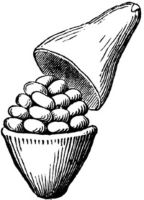 , sometimes a drupedrupe:
, sometimes a drupedrupe:
(indehiscent drupe) a fleshy, indehiscent fruit with one more hard pits enclosing seeds, derived from single, superior, simple or compound ovary; (dehiscent drupe) a fruit with a dry or fibrous to fleshy or leathery outer husk that early to tardily breaks apart (or opens), exposing one or more nutlike pits enclosing the seeds or nutnut:
or nutnut:
a fairly large, indehiscent, dry fruit with a thick and bony wall surrounding a single seed, derived from a single, simple or compound ovary , 0.5–20 mm long (to 100 mm long, esp. in cultivated Psidium), variable in shape, often cup-shaped to urceolateurceolate:
, 0.5–20 mm long (to 100 mm long, esp. in cultivated Psidium), variable in shape, often cup-shaped to urceolateurceolate:
3D shape—urn-shaped, hollow and contracted near the apex
, tereteterete:
approximately circular in cross section; width and thickness approximately equal
 in transection, stylestyle:
in transection, stylestyle:
in a flower, the narrow and elongated part of the pistil between the stigma and the ovary; sometimes persisting in fruit rarely persistent, sometimes winged, with usually one to several seeds, sometimes many, wholly or partially enclosed in hypanthium, crowned by persistent sepalssepal:
rarely persistent, sometimes winged, with usually one to several seeds, sometimes many, wholly or partially enclosed in hypanthium, crowned by persistent sepalssepal:
a member of the outer envelope of a flower (calyx)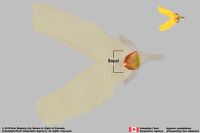 or scars. Sepals spreading and awned or feathery in a few genera. CapsulesCapsule:
or scars. Sepals spreading and awned or feathery in a few genera. CapsulesCapsule:
a dry, dehiscent fruit derived from a compound ovary fully exerted to wholly included within hypanthia, at maturity valves (usually 3–4) often visible at apexapex:
fully exerted to wholly included within hypanthia, at maturity valves (usually 3–4) often visible at apexapex:
the point farthest from the point of attachment, or the "tip" of an organ of fruits and protruding above the hypanthia. CapsulesCapsule:
of fruits and protruding above the hypanthia. CapsulesCapsule:
a dry, dehiscent fruit derived from a compound ovary are sometimes shed in a cluster or as a syncarpsyncarp:
are sometimes shed in a cluster or as a syncarpsyncarp:
fruit derived from fusion of numerous ovaries in a many-flowered inflorescence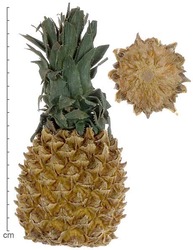 (e.g., Callistemon, Choricarpia, Eucalyptus spp.). In berriesberry:
(e.g., Callistemon, Choricarpia, Eucalyptus spp.). In berriesberry:
an indehiscent, fleshy fruit with one or a few to many seeds. The flesh may be homogenous throughout. Or, if the outer part is hard, firm, or leathery, referred to as an hesperidium. Septa are present in some, and the seeds may be arillate or with a fleshy testa. , hypanthial tissue is fleshy and extends to or above the ovary.
, hypanthial tissue is fleshy and extends to or above the ovary.
Pericarppericarp:
fruit wall or fruit coat
gray, black, purple, green, brown, yellow, red, or white, rarely blue, usually dulldull:
reflecting only a low proportion of incident light, with no apparent sheen , dry, thick- or thin-walled, fibrousfibrous:
, dry, thick- or thin-walled, fibrousfibrous:
texture -- long, flexible threads, thicker than hairs, that densely cover and obscure the surface , woodywoody:
, woodywoody:
texture—consisting mainly of indurate lignified tissues, characteristic of or resembling wood
, bonybony:
very hard and rather brittle, like bone
, paperypapery:
texture—papyraceous, chartaceous; very thin, pliable, and readily torn; like paper
, crustaceouscrustaceous:
texture—thin, dry, indurate, and brittle
or leatheryleathery:
texture—moderately thick, tough, and very pliable
capsulescapsule:
a dry, dehiscent fruit derived from a compound ovary , nutletsnutlet:
, nutletsnutlet:
˜achene
), or fleshy, spongyspongy:
soft, light, discontinuous but cohesive, and somewhat resilient
or succulentsucculent:
texture—herbaceous and juicy, often thickened
berriesberry:
an indehiscent, fleshy fruit with one or a few to many seeds. The flesh may be homogenous throughout. Or, if the outer part is hard, firm, or leathery, referred to as an hesperidium. Septa are present in some, and the seeds may be arillate or with a fleshy testa. , drupesdrupe:
, drupesdrupe:
(indehiscent drupe) a fleshy, indehiscent fruit with one more hard pits enclosing seeds, derived from single, superior, simple or compound ovary; (dehiscent drupe) a fruit with a dry or fibrous to fleshy or leathery outer husk that early to tardily breaks apart (or opens), exposing one or more nutlike pits enclosing the seeds , rarely capsulescapsule:
, rarely capsulescapsule:
a dry, dehiscent fruit derived from a compound ovary ), glabrousglabrous:
), glabrousglabrous:
without hairs
or pubescentpubescent:
surface relief—bearing hairs
, smooth or wrinkledwrinkled:
surface relief—shallow, irregular folds and furrows covering the surface; appearing overall though crumpled and then spread out , reticulatereticulate:
, reticulatereticulate:
surface relief—netted, raised walls or concave grooves forming a net-like surface pattern with flat, concave, or convex interspaces , pittedpitted:
, pittedpitted:
surface relief—surface with small depressions in which the areas between the hollows do not take on the appearance of a true reticular net , ribbedribbed:
, ribbedribbed:
surface relief—wide, prominent, linear ridges that are generally rounded and longitudinally situated on the surface , scalyscaly:
, scalyscaly:
surface relief—covered with small, thin, fine scales or flakes that may be removable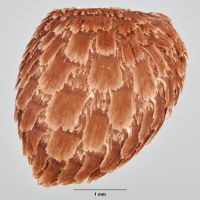 , or sometimes with dark glands or spines.
, or sometimes with dark glands or spines.
Note, the term operculumoperculum:
a dehiscent cap (or lid) of a seed or fruit that opens during germination or dehiscence when applied in Eucalyptus refers to the bud cap or caps enclosing the stamens and stylestyle:
when applied in Eucalyptus refers to the bud cap or caps enclosing the stamens and stylestyle:
in a flower, the narrow and elongated part of the pistil between the stigma and the ovary; sometimes persisting in fruit . Caps are formed from fused sepalssepal:
. Caps are formed from fused sepalssepal:
a member of the outer envelope of a flower (calyx) (outer) or fused petalspetal:
(outer) or fused petalspetal:
a member of the inner envelope of a flower (corolla)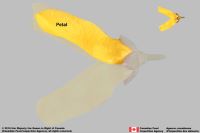 (inner), which fall away and leave scars on the hypanthial rim during anthesis. Not all species have both caps.
(inner), which fall away and leave scars on the hypanthial rim during anthesis. Not all species have both caps.
Seeds shape highly variable, usually compressedcompressed:
flattened; in grasses, used to denote compression (not necessarily flattened) either laterally or dorsiventrally
or flattened in transection, 0.6–8 mm, sometimes to 17 mm long. Seeds winged or not, if winged, then wings short and tail-like, at one or both ends, or marginalmarginal:
at, on, or close to the margin or border
. ArilsAril:
(broad sense) appendicular structure that wholly or partly envelops a seed and is produced from or a modification of the funicle, raphe, or outer integument; usually fleshy or pulpy, sometimes spongy or tufted-capillate, often brightly colored sometimes present, if present, then pale or white. Seed coat gray, black, brown, reddish brown, yellow, orange, or red, sometimes flecked, shinyshiny:
sometimes present, if present, then pale or white. Seed coat gray, black, brown, reddish brown, yellow, orange, or red, sometimes flecked, shinyshiny:
uniformly reflecting a high proportion of incident light at all angles (usually when coat hardened) or dulldull:
(usually when coat hardened) or dulldull:
reflecting only a low proportion of incident light, with no apparent sheen , glabrousglabrous:
, glabrousglabrous:
without hairs
, smooth or ornamented. Seed coat texture variable, crustaceouscrustaceous:
texture—thin, dry, indurate, and brittle
, thin- to thick-walled, membranousmembranous:
texture—extremely thin, pliable, and fairly tough
, paperypapery:
texture—papyraceous, chartaceous; very thin, pliable, and readily torn; like paper
, leatheryleathery:
texture—moderately thick, tough, and very pliable
, or hard and bonybony:
very hard and rather brittle, like bone
or woodywoody:
texture—consisting mainly of indurate lignified tissues, characteristic of or resembling wood
. Hila are sometimes visible, if visible to 0.3 mm long, ventralventral:
adaxial; of the side of an organ facing the axis (compare dorsal)
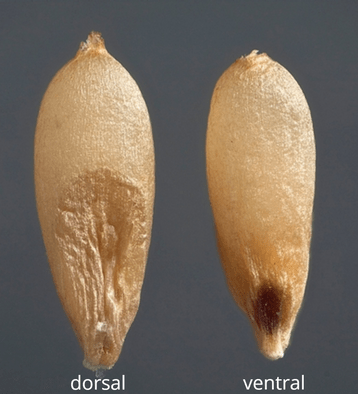 or terminal, and may be in a cavity. Seed characteristics are diagnostically useful in Eucalyptus.
or terminal, and may be in a cavity. Seed characteristics are diagnostically useful in Eucalyptus.
Embryo well-developed, except in Eugenia (undifferentiated), completely to nearly filling seed cavity, green or white, linearlinear:
(shape) long, narrow, and uniform in width; (of embryo) embryo is straight and much longer than wide or foliatefoliate:
or foliatefoliate:
appearing leaf-like
, straight to coiledcoiled:
(of embryo) linear embryo is very long and bent to form a coil whereby one end of the embryo is on the outside and the other end near the middle of the seed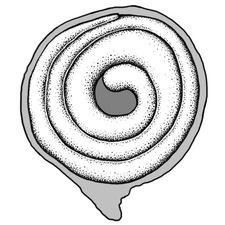 , with connate or separate, often intricately folded, investinginvesting:
, with connate or separate, often intricately folded, investinginvesting:
(of embryo) embryo is nearly or completely filling seed coat, straight, and axile and centric with spatulate cotyledons and covering the stalk for at least half its length; (of cotyledons) cotyledons spatulate and covering the stalk for at least half its length
or spatulatespatulate:
2D shape—like a spatula; rounded at the apex, with base long and tapered; (of embryo) embryo is straight and axile and centric with the cotyledons expanded to form the shape of a spatula or spoon; (of cotyledons) cotyledons expanded and wider than the stalk but not invested into the stalk , entire cotyledons. Cotyledons are often very small. Some genera with myrcioid embryos or embryos, which completely fill the seed cavity and have foliaceous cotyledons, which are crumpled and folded along the elongate radicleradicle:
, entire cotyledons. Cotyledons are often very small. Some genera with myrcioid embryos or embryos, which completely fill the seed cavity and have foliaceous cotyledons, which are crumpled and folded along the elongate radicleradicle:
the embryonic root of the embryo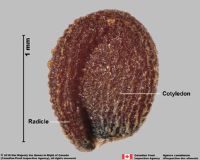 . Syzygium cotyledons thick and planoconvex.
. Syzygium cotyledons thick and planoconvex.
Endosperm scanty or absent.
Noxious Weed: USA Federal Noxious Weed List, aquatic, Melaleuca quinquenervia (Cav.) S.T. Blake.
Federal Noxious Weed Disseminules of the US tool provides a description and image of this species. Aquarium & Pond Plants of the World tool also includes descriptions and images of Melaleuca.
| Fruit | |
| Type | berryberry: an indehiscent, fleshy fruit with one or a few to many seeds. The flesh may be homogenous throughout. Or, if the outer part is hard, firm, or leathery, referred to as an hesperidium. Septa are present in some, and the seeds may be arillate or with a fleshy testa.  , capsulecapsule: , capsulecapsule:a dry, dehiscent fruit derived from a compound ovary  , sometimes drupedrupe: , sometimes drupedrupe:(indehiscent drupe) a fleshy, indehiscent fruit with one more hard pits enclosing seeds, derived from single, superior, simple or compound ovary; (dehiscent drupe) a fruit with a dry or fibrous to fleshy or leathery outer husk that early to tardily breaks apart (or opens), exposing one or more nutlike pits enclosing the seeds  or nutnut: or nutnut:a fairly large, indehiscent, dry fruit with a thick and bony wall surrounding a single seed, derived from a single, simple or compound ovary  |
| Size range | 0.5–20 mm long (to 100 mm long, esp. in cultivated Psidium) |
| Shape(s) | globoseglobose: 3D shape—more or less spherical  , hemisphericalhemispherical: , hemisphericalhemispherical:2D shape—shaped like half a sphere , cup-shaped, campanulatecampanulate: 3D shape—bell-shaped, circular in cross-section, inflated proximally, broadening gradually until flared distally , urceolateurceolate: 3D shape—urn-shaped, hollow and contracted near the apex , ellipsoidellipsoid: 3D shape—elliptic , conicalconical: 3D shape—cone-shaped, with the point of attachment at the broad end 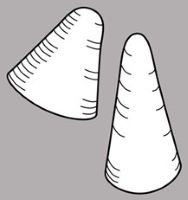 , cylindricalcylindrical: , cylindricalcylindrical:3D shape—a cylinder, with parallel sides and a circular cross-section; tubular or rod-shaped , fusiformfusiform: spindle-shaped; broadest at the middle and tapering at both ends  , obovoidobovoid: , obovoidobovoid:3D shape—obovate , pear-shaped, rectangular, cuboid, angularangular: 2D shape—having sides that meet at acute or obtuse angles |
| Texture |
capsulescapsule: |
| Surface relief | smooth, wrinkledwrinkled: surface relief—shallow, irregular folds and furrows covering the surface; appearing overall though crumpled and then spread out  , reticulatereticulate: , reticulatereticulate:surface relief—netted, raised walls or concave grooves forming a net-like surface pattern with flat, concave, or convex interspaces  , pittedpitted: , pittedpitted:surface relief—surface with small depressions in which the areas between the hollows do not take on the appearance of a true reticular net  , ribbedribbed: , ribbedribbed:surface relief—wide, prominent, linear ridges that are generally rounded and longitudinally situated on the surface  , scalyscaly: , scalyscaly:surface relief—covered with small, thin, fine scales or flakes that may be removable  , or sometimes with dark glands or spines , or sometimes with dark glands or spines |
| Color(s) | gray, black, purple, green, brown, yellow, red, white, rarely blue |
| Unique features | BerriesBerry: an indehiscent, fleshy fruit with one or a few to many seeds. The flesh may be homogenous throughout. Or, if the outer part is hard, firm, or leathery, referred to as an hesperidium. Septa are present in some, and the seeds may be arillate or with a fleshy testa.  or capsulescapsule: or capsulescapsule:a dry, dehiscent fruit derived from a compound ovary  often thick-walled and crowned by persistent sepalsepal: often thick-walled and crowned by persistent sepalsepal:a member of the outer envelope of a flower (calyx)  lobes or scars, with few to several seeds and chaff, rarely many-seeded. CapsulesCapsule: lobes or scars, with few to several seeds and chaff, rarely many-seeded. CapsulesCapsule:a dry, dehiscent fruit derived from a compound ovary  often woodywoody: often woodywoody:texture—consisting mainly of indurate lignified tissues, characteristic of or resembling wood , cup-shaped to urceolateurceolate: 3D shape—urn-shaped, hollow and contracted near the apex with 3 or 4 valvate tips extending beyond rim, and more chaff (derived from aborted seeds) than seeds. |
| Seed | |
| Size range | 0.6–8 mm, sometimes to 17 mm long |
| Shape(s) | discoiddiscoid: 3D shape—resembling a disc 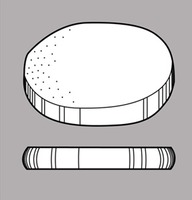 , deltoid, globoseglobose: , deltoid, globoseglobose:3D shape—more or less spherical  , lens-shapedlens-shaped: , lens-shapedlens-shaped:2D shape—round and flattened with two curved (convex) surfaces , plano-convexplano-convex: 2D or 3D shape—flat on one side, convex on the other 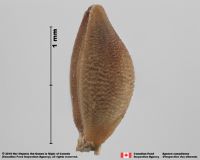 , ellipsoidellipsoid: , ellipsoidellipsoid:3D shape—elliptic , linearlinear: (shape) long, narrow, and uniform in width; (of embryo) embryo is straight and much longer than wide  , ovoidovoid: , ovoidovoid:3D shape—ovate  , obovoidobovoid: , obovoidobovoid:3D shape—obovate , pyramidalpyramidal: 3D shape—pyramid-shaped (compare obpyramidal) 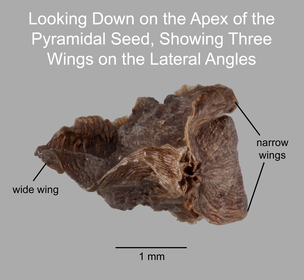 , reniformreniform: , reniformreniform:2D or 3D shape—kidney-shaped  , C-shapedC-shaped: , C-shapedC-shaped:2D-shape—semiannulate, curved into the shape of the letter 'C' , coiledcoiled: (of embryo) linear embryo is very long and bent to form a coil whereby one end of the embryo is on the outside and the other end near the middle of the seed  , D-shapedD-shaped: , D-shapedD-shaped:2D shape—has one straight margin and one curved margin, resembling the shape of the letter D , wedge-shapedwedge-shaped: 2D shape—triangular and tapering to a point at the base 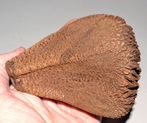 , angularangular: , angularangular:2D shape—having sides that meet at acute or obtuse angles , cuboid, cymbiformcymbiform: 3D shape - boat-shaped, navicular , cochleatecochleate: snail-shell-shaped. Relatively broad and short, basically round in transverse section, resembling a rapidly tapering spire overall, the exterior helically convoluted; like a snail shell 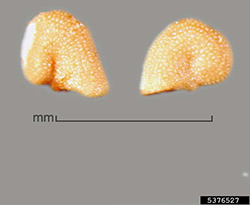 |
| Surface relief | smooth, striatestriate: surface relief—having fine, parallel lines, grooves or ridges  , ribbedribbed: , ribbedribbed:surface relief—wide, prominent, linear ridges that are generally rounded and longitudinally situated on the surface  , furrowed, colliculatecolliculate: , furrowed, colliculatecolliculate:surface relief—covered with small, round projections, similar to blistered 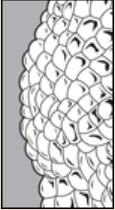 , pittedpitted: , pittedpitted:surface relief—surface with small depressions in which the areas between the hollows do not take on the appearance of a true reticular net  , reticulatereticulate: , reticulatereticulate:surface relief—netted, raised walls or concave grooves forming a net-like surface pattern with flat, concave, or convex interspaces  , areolate, tuberculatetuberculate: , areolate, tuberculatetuberculate:surface relief—bearing small, warty, swelling, rounded, or variously shaped projections  , papillatepapillate: , papillatepapillate:surface relief—bearing minute, distinct, broad-based projections, tapering to a rounded apex  , facetted, wrinkledwrinkled: , facetted, wrinkledwrinkled:surface relief—shallow, irregular folds and furrows covering the surface; appearing overall though crumpled and then spread out  , with cavities , with cavities |
| Color(s) | gray, black, brown, reddish brown, yellow, orange, red, sometimes flecked |
| Unique features | Usually flattened or compressedcompressed: flattened; in grasses, used to denote compression (not necessarily flattened) either laterally or dorsiventrally seeds usually with well-developed curvedcurved: (of embryo) linear embryo is curved into an arch or horseshoe with the ends far apart  to coiledcoiled: to coiledcoiled:(of embryo) linear embryo is very long and bent to form a coil whereby one end of the embryo is on the outside and the other end near the middle of the seed  embryos, completely to nearly completely filling the seed cavity, and with intricately folded cotyledons. embryos, completely to nearly completely filling the seed cavity, and with intricately folded cotyledons. |
| Other | |
| Embryo | well-developed, except in Eugenia (undifferentiated), completely to nearly filling seed cavity, green or white, linearlinear: (shape) long, narrow, and uniform in width; (of embryo) embryo is straight and much longer than wide  or foliatefoliate: or foliatefoliate:appearing leaf-like , straight to coiledcoiled: (of embryo) linear embryo is very long and bent to form a coil whereby one end of the embryo is on the outside and the other end near the middle of the seed  , with connate or separate, often intricately folded, investinginvesting: , with connate or separate, often intricately folded, investinginvesting:(of embryo) embryo is nearly or completely filling seed coat, straight, and axile and centric with spatulate cotyledons and covering the stalk for at least half its length; (of cotyledons) cotyledons spatulate and covering the stalk for at least half its length or spatulatespatulate: 2D shape—like a spatula; rounded at the apex, with base long and tapered; (of embryo) embryo is straight and axile and centric with the cotyledons expanded to form the shape of a spatula or spoon; (of cotyledons) cotyledons expanded and wider than the stalk but not invested into the stalk  , entire cotyledons , entire cotyledons |
| Nutritive tissue | endosperm scanty or absent |
Pantropical and warm-temperate regions
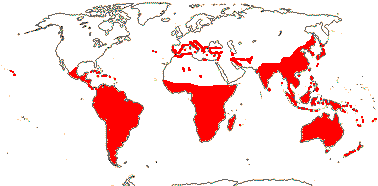
Distribution map courtesy of Angiosperm Phylogeny Website.
Centre for Australian National Biodiversity Research 2020Centre for Australian National Biodiversity Research 2020:
Centre for Australian National Biodiversity Research. 2020. EUCLID Eucalypts of Australia Edition 4. Accessed May 2024. URL: https://apps.lucidcentral.org/euclid/text/intro/learn.htm; Craven 1987aCraven 1987a:
Craven LA. 1987a. A taxonomic revision of Calytrix Labill. (Myrtaceae). Brunonia 10: 1–138.; Craven 1987bCraven 1987b:
Craven LA. 1987b. A taxonomic revision of Homalocalyx F. Muell. (Myrtaceae). Brunonia 10: 139–158.; Flora of Australia 2021+Flora of Australia 2021+:
Flora of Australia. Australian Biological Resources Study, Canberra. Accessed January 2021–March 2024. URL: http://www.ausflora.org.au; Flora of North America Editorial Committee 1993+Flora of North America Editorial Committee 1993+:
Flora of North America Editorial Committee, eds. 1993+. Flora of North America North of Mexico [Online]. 22+ vols. Flora of North America Association, New York and Oxford. Accessed January-March 2024. URL: http://beta.floranorthamerica.org.; Hill and Johnson 1995Hill and Johnson 1995:
Hill KD and Johnson LAS. 1995. Systematic studies in the eucalypts 7. A revision of the bloodwoods, genus Corymbia (Myrtaceae). Telopea 6: 185–504.; Keighery 2002Keighery 2002:
Keighery GJ. 2002. A review of the genus Pileanthus (Myrtaceae). Nuytsia 15: 37–51.; Kirkbride et al. 2006Kirkbride et al. 2006:
Kirkbride JH, Jr, Gunn CR, and Dallwitz MJ. 2006. Family guide for fruits and seeds, vers. 1.0. Accessed September 2020-January 2022. URL: https://nt.ars-grin.gov/seedsfruits/keys/frsdfam/index.cfm .; Kubitzki et al. 1990+Kubitzki et al. 1990+:
Kubitzki K et al., eds. 1990+. The families and genera of vascular plants. 7+ vols. Berlin etc.; Rye 2002Rye 2002:
Rye BL. 2002. A revision of the south-western Australian species of Micromyrtus (Myrtaceae) with five antisepalous ribs on the hypanthium. Nuytsia 15(1): 101–122. https://www.biodiversitylibrary.org/page/61882251; Rye 2009Rye 2009:
Rye BL. 2009. A reduced circumscription of Balaustion and description of the new genus Cheyniana (Myrtaceae: Chamelaucieae). Nuytsia 19(1): 129–148. https://florabase.dbca.wa.gov.au/science/nuytsia/467.pdf; Rye 2013Rye 2013:
Rye BL. 2013. An update to the taxonomy of some Western Australian genera of Myrtaceae tribe Chamelaucieae. 1. Calytrix. Nuytsia 23: 483–501. https://www.biodiversitylibrary.org/page/60009931#page/184/mode/1up; Rye 2014Rye 2014:
Rye BL. 2014. An update to the taxonomy of some Western Australian genera of Myrtaceae tribe Chamelaucieae. 3. Thryptomene. Nuytsia 24: 296–306. https://www.biodiversitylibrary.org/page/60020662; Rye 2022Rye 2022:
Rye BL. 2022. An expanded circumscription and revision of the Western Australian genus Balaustion (Myrtaceae: Chamelaucieae: Hysterobaeckeineae). Nuytsia 33: 149–204. https://www.biodiversitylibrary.org/page/62548757; Rye and Trudgen 2001Rye and Trudgen 2001:
Rye BL and Trudgen ME. 2001. A taxonomic revision of Thryptomene section Thryptomene (Myrtaceae). Nuytsia 13(3): 509–528.; Rye and Wilson 2022Rye and Wilson 2022:
Rye BL and Wilson PG. 2022. Reduction of Corynanthera to the synonym of Micromyrtus (Myrtaceae: Chamelaucieae: Micromyrtinae). Nutysia 33: 321–324. https://www.biodiversitylibrary.org/page/62548930; Rye et al. 2022Rye et al. 2022:
Rye BL, Keighery GJ, and Barrett MD. 2022. Description of the new south-western Australian plant group, Hypocalymma sect. Grandiflora (Myrtaceae: Chamelaucieae: Astarteinae). Nuytsia 33: 233–249. https://www.biodiversitylibrary.org/page/62548841; Takhtajan 2009Takhtajan 2009:
Takhtajan A. 2009. Flowering plants: Second edition. Springer Nature, Switzerland. 871 pp.; Thiele et al. 2022Thiele et al. 2022:
Thiele KR, Keighery GJ, Nge FJ, and Rye BL. 2022. Three new Western Australian species related to Calytrix violaceae (Myrtaceae: Chamelaucieae). Nuytsia 33: 221–232.; Trudgen 2001Trudgen 2001:
Trudgen ME. 2001. Reinstatement and revision of Euryomyrtus (Myrtaceae). Nuytsia 13(3): 543–566. https://www.biodiversitylibrary.org/page/53424795; Wheeler et al. 2001Wheeler et al. 2001:
Wheeler JR, Marchant NG, and Robinson CJ. 2001. Agonis fragrans (Myrtaceae), a new species from Western Australia. Nuytsia 13(3): 567–570. https://www.biodiversitylibrary.org/page/53424819; Zhengyi et al. 2004+Zhengyi et al. 2004+:
Zhengyi W, Raven PH, and Deyuan H. 2004+. Flora of China [online]. 25 vols. Science Press, Beijing China & Missouri Botanical Garden, St. Louis USA. Accessed January–March 2024. http://flora.huh.harvard.edu/china/
*The number of genera and species is based on Christenhusz and Byng 2016Christenhusz and Byng 2016:
Christenhusz MJM and Byng JW. 2016. The number of known plant species in the world and its annual increase. Phytotaxa 261 (3): 201-217. https://doi.org/10.11646/phytotaxa.261.3.1, which may differ from the number of genera in GRIN-Global.